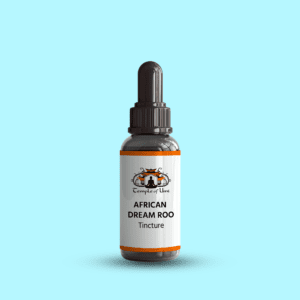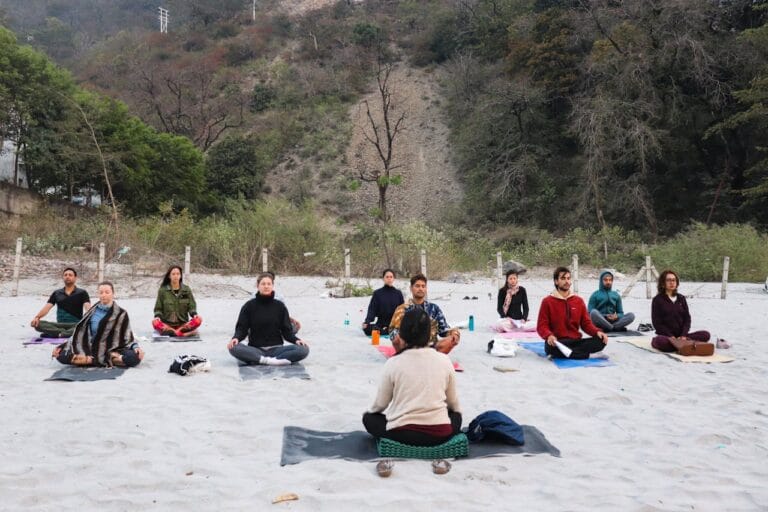Guided meditation
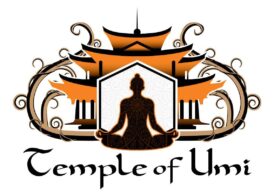
By Temple of Umi
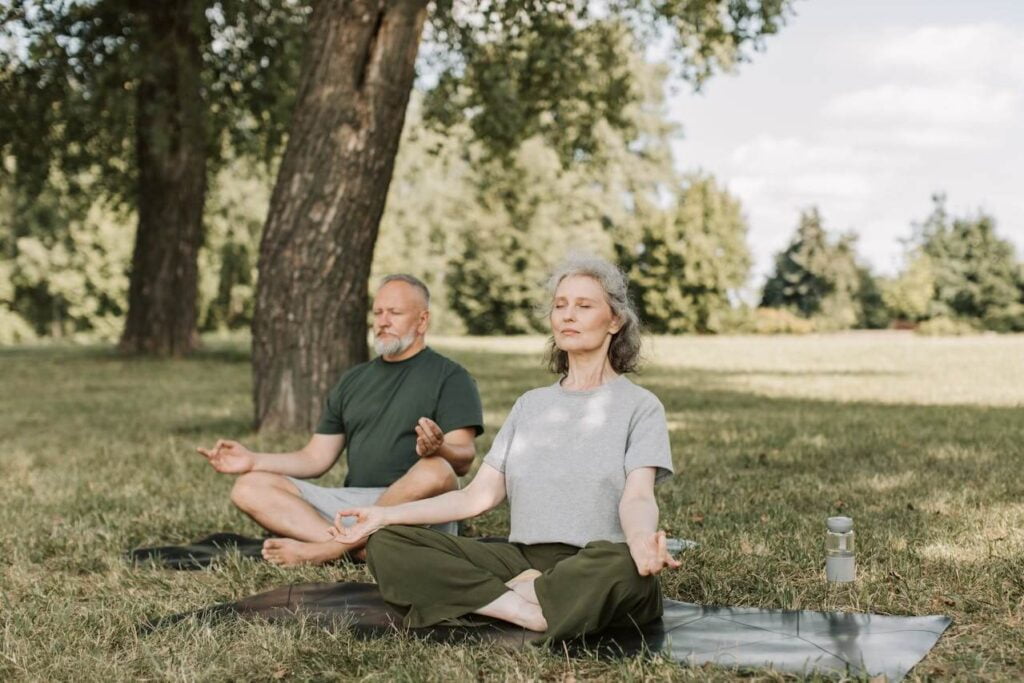
Table of Contents
Discover how guided meditation can transform your life with tailored practices for stress relief, improved sleep, and enhanced focus. Explore personalized meditation techniques to achieve your specific goals and embrace a journey towards a more balanced life.
Introduction to Guided Meditation
Definition and Overview Guided Meditation is a transformative practice that involves being led by a narrator or instructor through a meditative experience. This form of Meditation utilizes verbal cues, storytelling, and visualization techniques to guide participants through self-discovery and relaxation. Designed to engage the mind and body, it allows individuals to focus their attention, eliminate the stream of jumbled thoughts, and reach a state of peace and inner calm.
The Evolution of Guided Meditation in Wellness Practices Historically, Meditation has roots in various cultures and religions worldwide, evolving over thousands of years. Guided Meditation, as we know it today, has become a cornerstone of modern wellness practices, adapting ancient traditions for contemporary life. From its early incorporation in spiritual and healing rituals to its present-day application in stress management programs, digital apps, and wellness retreats, guided Meditation has significantly transformed. Its accessibility and adaptability have made it a popular choice among people seeking to improve their mental health and well-being.
Benefits of Incorporating Guided Meditation into Your Daily Routine
- Stress Reduction: Regular practice can significantly lower stress levels, improving overall health.
- Enhanced Focus and Clarity: Helps clear the mind, improves focus, and boosts productivity.
- Emotional Balance: Aids in managing emotions, contributing to better relationships and self-understanding.
- Improved Sleep: It can relax the mind and body, making it easier to fall asleep and improving the quality of rest.
- Increased Creativity: By quieting the mind, it opens up space for creative thoughts to emerge.
Understanding the Mechanics of Guided Meditation
How Guided Meditation Works: The Role of Voice and Visualization Guided Meditation leverages the power of the spoken word and vivid imagery to create an immersive experience. The guide’s voice plays a crucial role, setting a calm and safe tone and leading the listener through a narrative or series of visualizations. These mental images are designed to engage the senses, transporting the meditator to peaceful settings or guiding them through processes of self-reflection and discovery.
The Science Behind Guided Meditation: From Stress Reduction to Enhanced Creativity Research supports Meditation’s efficacy in various mental and physical health areas. Neuroscientific studies reveal that this practice can alter brain patterns, reducing areas associated with anxiety and stress while enhancing those related to emotional regulation, creativity, and problem-solving abilities. Promoting relaxation and mindfulness contributes to a healthier, more resilient brain. Learn more.
Different Types of Guided Meditation: Exploring Techniques and Themes
- Mindfulness Meditation: Focuses on being intensely aware of what you’re sensing and feeling in the moment, without interpretation or judgment.
- Visualization: Involves forming mental images of places or situations you find relaxing.
- Loving-kindness Meditation: Aims to cultivate an attitude of love and kindness toward everything, even a person’s enemies and sources of stress.
- Body Scan Meditation: This entails paying attention to parts of the body and bodily sensations gradually from feet to head.
- Breath Awareness Meditation: Encourages mindful breathing to focus the mind and reduce wandering thoughts.
Preparing for Your Guided Meditation Experience
Embarking on the path of guided Meditation opens a world of tranquillity, self-discovery, and mental clarity. The initial step in this transformative journey involves meticulous preparation to ensure an enriching experience. Here’s how to lay the groundwork for a fruitful guided meditation practice.
Setting Up Your Meditation Space: Creating a Serene Environment
- Choose a Quiet Spot: Find a peaceful corner free from interruptions. A dedicated space signals your brain it’s time to unwind.
- Comfort is Key: Ensure the area is comfortable. A cushion or chair that supports your posture can enhance the experience.
- Personalize Your Space: Incorporate elements that soothe your senses, such as scented candles, soft lighting, or calming visuals.
- Minimize Distractions: Keep gadgets and unnecessary items out of sight to maintain focus.
Choosing Your Guide: Apps, Online Resources, and Instructors
- Explore Meditation Apps: Apps like Headspace or Calm offer guided sessions catering to various needs, from sleep to stress management.
- Online Resources: YouTube and meditation websites are treasure troves of guided sessions led by seasoned practitioners.
- Selecting Instructors: If you prefer a more personal touch, look for local meditation centres or instructors with a style that resonates with you.
What to Expect During Your First Guided Meditation Session
- Embrace the Newness: Initial sessions might feel unusual. Embrace the experience without judgment.
- Physical Sensations: You may notice relaxation in your body or slight discomfort as you find your ideal posture.
- Fluctuating Focus: Your mind might wander, and that’s perfectly normal. Guided Meditation gently brings your attention back.
- A Sense of Peace: Many report a profound sense of peace or emotional release after the session. Your experience will be uniquely yours. Learn more.
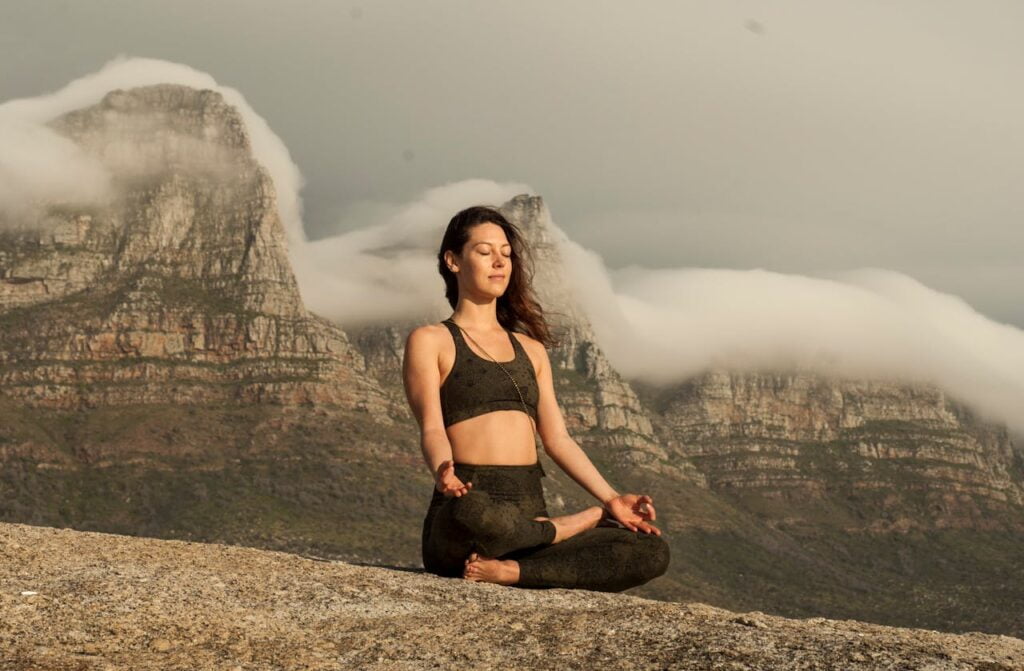
Deep Dive into Guided Meditation Practices
Guided Meditation offers a tapestry of practices, each with unique flavor and benefits. Whether you seek relaxation, awareness, or healing, there’s a practice tailored to your journey.
Guided Imagery: A Journey Through the Senses
- Vivid Visualization: Engage your imagination to visit serene landscapes or relive joyful memories guided by a soothing voice.
- Sensory Engagement: This practice enhances sensory awareness, deepening the meditation experience through imagined sights, sounds, and sensations.
Mindfulness Meditation: Cultivating Awareness and Presence
- Living in the Moment: Focus on the present, observing thoughts and feelings without judgment. This practice fosters a deep sense of awareness and inner calm.
- Breath as an Anchor: Use your breath to anchor your attention, helping to maintain focus amidst the ebb and flow of thoughts.
Loving-Kindness Meditation: Fostering Compassion and Empathy
- Cultivating Kindness: Direct positive energy towards yourself and others through repeated phrases. This practice nurtures a compassionate and empathetic heart.
- Expanding Your Circle: Start with yourself, then gradually extend your well-wishes to loved ones, acquaintances, and even those with difficulties.
Body Scan Meditation: Attuning to Physical Sensations for Deep Relaxation
- Mind-Body Connection: Pay attention to different body parts, noticing tension or discomfort. This awareness promotes a deep state of relaxation.
- Sequential Focus: Typically starting from the toes and moving upwards, this methodical focus helps release stress and enhance mental and physical well-being.
Enhancing Your Guided Meditation Practice
Embarking on a guided meditation journey opens the door to a serene mind and a harmonized life. To elevate this experience, integrating other wellness practices can create a holistic well-being approach. Here’s how you can enhance your guided meditation practice for profound effects on your mind, body, and spirit.
Combining Guided Meditation with Other Wellness Practices
- Yoga: Unite body and mind by incorporating yoga with guided meditation sessions. Start with a yoga routine to release physical tension and a guided meditation to soothe the mind.
- Journaling: After a guided meditation session, jot down your thoughts, feelings, and revelations. This practice can deepen your self-awareness and enhance the meditative experience.
- Nature Walks: After Meditation, engage in mindful walking in nature. The natural environment can amplify the calming effects of Meditation, grounding you in the present moment.
Tips for Overcoming Common Challenges in Meditation
- Distractions: Create a dedicated meditation space where you’re less likely to be disturbed. Use noise-cancelling headphones with your guided Meditation to maintain focus.
- Restlessness: If you find it hard to stay still, start with short, guided meditations. Gradually increase the duration as your mind and body acclimate to stillness.
- Consistency: Set a regular meditation schedule. Consistency reinforces it as a habit, making it a natural part of your daily routine.
Tracking Your Progress: Reflective Practices and Mindfulness Journals
- Keep a mindfulness journal dedicated to your meditation journey. Note the duration, the type of guided Meditation, and any thoughts or emotions that arise.
- Reflect on your progress weekly. Look for patterns or improvements in your emotional state, stress levels, and overall well-being. Learn more.
Advanced Guided Meditation Techniques
As your guided meditation practice deepens, exploring advanced techniques can unlock new levels of self-discovery and inner peace. Here are some methods to consider:
Exploring Chakra Meditation for Energy Balancing
- Chakra meditation focuses on the body’s seven energy centres. Guided meditations are designed to align and balance the chakras, facilitating improved energy flow and well-being.
Visualization Techniques for Personal Growth and Manifestation
- Engage in guided meditations that incorporate visualization. Imagine achieving personal goals or embodying desired traits. This technique harnesses the power of the mind to influence personal growth and reality.
Integrative Breathwork: Enhancing Meditation with Focused Breathing
- Combine guided Meditation with controlled breathing techniques. Breathwork can intensify the meditation experience, promoting more profound relaxation and mental clarity.
Each of these practices can significantly enhance the quality of your guided meditation sessions. By exploring and integrating these techniques, you create a tailored meditation practice that supports your unique path to wellness and personal fulfilment. Learn more.
Guided Meditation for Specific Goals
Guided Meditation serves as a versatile tool, catering to various personal objectives. Here are ways it addresses specific needs:
- Stress Relief and Anxiety Reduction:
- Guided Meditation provides a sanctuary for the mind and a route to peace amidst chaos. Through visualization and breathing techniques, individuals learn to release tension, fostering a state of calm.
- Practices such as mindfulness meditation teach the art of living in the present, significantly lowering anxiety levels by reducing worry about the future and regrets over the past.
- Improving Sleep and Combatting Insomnia:
- Sleep-focused guided meditation techniques involve relaxation and visualization strategies that prepare the mind and body for rest, combating insomnia.
- Listening to guided meditation tracks before bed can improve sleep quality, guiding the listener into a deeper, more restorative sleep.
- Enhancing Focus and Productivity in Work and Creativity:
- Meditation practices that focus on mindfulness clear the mind and enhance concentration, leading to greater productivity and creativity in work-related tasks.
- Regular guided meditation sessions help develop a sharper focus, enabling individuals to approach tasks calmly and clearly and fostering innovation and efficiency. Learn more.
The Future of Guided Meditation
Guided Meditation is evolving, integrating with technology and expanding its reach and effectiveness:
- Emerging Trends in Meditation Technology:
- The advent of VR (Virtual Reality) meditation offers immersive experiences, placing individuals in serene environments to enhance the meditation experience.
- AI-powered apps personalize meditation practices, adapting to the user’s emotional state and preferences to offer the most effective meditation guidance.
- The Expanding Role of Guided Meditation in Healthcare and Therapy:
- Medical professionals are increasingly incorporating guided Meditation into treatment plans for mental health issues, recognizing its benefits in reducing stress, anxiety, and depression.
- Guided Meditation is used in therapy sessions as a complementary practice, helping patients manage symptoms of various conditions and improve their overall well-being.
- Building a Community: Group Meditation Practices and Retreats:
- The rise of group meditation practices and retreats emphasizes community and shared experiences, offering support and a sense of belonging among practitioners.
- These gatherings allow individuals to deepen their practice, learn from others, and experience guided Meditation in a powerful, collective setting. Learn more.

Final words
- Recap of the Transformative Power of Guided Meditation:
- Guided Meditation offers a path to personal transformation, helping individuals navigate life’s challenges more easily and clearly. Its versatility allows it to cater to various goals, from stress reduction to enhanced creativity.
- Encouragement to Explore Guided Meditation Further:
- Whether you’re seeking solace from stress, a night of restful sleep, or a boost in productivity, guided Meditation holds the key. Please explore this practice further and discover its profound benefits.
- Resources for Deepening Your Meditation Practice:
- Explore apps, online resources, and local meditation centres to deepen your meditation practice. Engaging with a community can enhance your experience and provide support as you journey through the transformative world of guided Meditation.
Optimizing your life through guided Meditation addresses specific goals and opens the door to exploring inner landscapes, fostering a deep connection with oneself. The future of guided Meditation is bright, with technology and community playing pivotal roles in its evolution. As we move forward, the essence of guided Meditation remains a beacon of peace, mindfulness, and personal growth.
- Sacred Plant Medicine Retreats in Georgia
- 5 Ayahuasca Retreats in California Worth Exploring
- 7 Best Aya Retreats in America. Click here.
- Mcdonough Ayahuasca retreat
- Conley Ayahuasca retreat
- Whitesburg Ayahuasca retreat
- Brooks Ayahuasca retreat
- Gay Ayahuasca retreat
- Williamson Ayahuasca retreat
- Orchard Hill Ayahuasca retreat
- Glenn Ayahuasca retreat
- Luthersville Ayahuasca retreat
- Shady Dale Ayahuasca retreat
- Bowdon Junction Ayahuasca retreat
- Sargent Ayahuasca retreat
- Greenville Ayahuasca retreat
- Lovejoy Ayahuasca retreat
- Winston Ayahuasca retreat
- Rutledge Ayahuasca retreat
- Moreland Ayahuasca retreat
- Molena Ayahuasca retreat
- Lebanon Ayahuasca retreat
- Good Hope Ayahuasca retreat
- Haralson Ayahuasca retreat
- An Inclusive List of Psychedelic Quotes
- Mount Ayahuasca retreat
- Grantville Ayahuasca retreat
- Pine Lake Retreat near
- Rydal Ayahuasca retreat
- Porterdale Ayahuasca retreat
- Waco Ayahuasca retreat
- Temple Ayahuasca retreat
- Bethlehem Ayahuasca retreat
- Jenkinsburg Ayahuasca retreat
- Adairsville Ayahuasca retreat
- Red Oak Ayahuasca retreat
- Woodbury Ayahuasca retreat
- Cassville Ayahuasca retreat
- Redan Ayahuasca retreat
- North Decatur Ayahuasca retreat
- Grantville Ayahuasca retreat
- Hillsboro Ayahuasca retreat
- Jackson Ayahuasca retreat
- Braselton Ayahuasca retreat
- Zebulon Ayahuasca retreat
- Flovilla Ayahuasca retreat
- Auburn Ayahuasca retreat
- Warm Springs Ayahuasca retreat
- Scottdale Ayahuasca retreat
- Lithia Springs Ayahuasca retreat
- Villa Rica Ayahuasca retreat
- Grayson Ayahuasca retreat
- Sunny Side Ayahuasca retreat
- Senoia Ayahuasca retreat
- Locust Grove Ayahuasca retreat
- Chamblee Ayahuasca retreat
- Fairburn Ayahuasca retreat
- Snellville Ayahuasca retreat
- Monticello Ayahuasca retreat
- Union City Ayahuasca retreat
- Tallapoosa Ayahuasca retreat
- Bremen Ayahuasca retreat
- Hampton Ayahuasca retreat
- Monroe Ayahuasca retreat
- Marble Hill Ayahuasca retreat
- Madison Ayahuasca retreat
- Dawsonville Ayahuasca retreat
- Felton Ayahuasca retreat
- Concord Ayahuasca retreat
- Mansfield Ayahuasca retreat
- Taylorsville Ayahuasca retreat
- Roopville Ayahuasca retreat
- Turin Ayahuasca retreat
- Franklin Ayahuasca retreat
- Clarkdale Ayahuasca retreat
- Talking Rock Ayahuasca retreat
- Jersey Ayahuasca retreat
- Kingston Ayahuasca retreat
- Bostwick Ayahuasca retreat
- North Metro Ayahuasca retreat
- Meansville Ayahuasca retreat
- Social Circle Ayahuasca retreat
- White Ayahuasca retreat
- Rhode Island Ayahuasca retreat
- Maryland Ayahuasca retreat
- Delaware Ayahuasca retreat
- New Jersey Ayahuasca retreat
- Connecticut Ayahuasca retreat
- Massachusetts Ayahuasca retreat
- Hampshire Ayahuasca retreat
- Pennsylvania Ayahuasca retreat
- New York Ayahuasca retreat
- Florida Ayahuasca retreat
- South Carolina Ayahuasca Retreat
- North Carolina Ayahuasca Retreat
- West West Virginia Ayahuasca retreat
- Virginia Ayahuasca retreat
- Ohio Ayahuasca retreat
- Alabama Ayahuasca retreat
- Mississippi Ayahuasca retreat
- Tennessee Ayahuasca retreat
- Kentucky Ayahuasca retreat
- IndianaAyahuasca retreat
- ILLINOIS Ayahuasca retreat
- Missouri Ayahuasca retreat
- Arkansas Ayahuasca retreat
- Louisiana Ayahuasca retreat
- Texas Ayahuasca retreat
- Oklahoma Ayahuasca retreat
- KansasAyahuasca retreat
- Ayahuasca retreats near me in Experiment.
- A wellness retreat in Georgia
- What is Ayahuasca?
- Embark on a Journey of Transformation with Spiritual Healing
- Unveiling Healing Energy at the Temple of Umi
- 10 Energy Healing Techniques to Transform Your Life
- Where to get Ayahuasca in the USA
- Top Ayahuasca retreats in the USA. Learn more.
- Cost of Ayahuasca Retreat: Balancing Cost and Experience. Learn more.
- What is trauma bonding?
- A Journey into the Healing Properties of Psychedelic Mushrooms. Learn more.
- Ayahuasca Retreat Georgia – Experience Spiritual Awakening
- Spiritual Retreats Georgia
- Shaman in America Exploration
- Shamanism – Shamanic healing
- Shaman Healing Guide
- Ayahuasca ceremonies Ayahuasca ceremonies near you in the USA
- Ayahuasca Experience
- DMT Journey, Benefits, and Side Effects
- Iowaska – What is it?
- Plant medicine retreats in Georgia
- Why massage is beneficial, according to a cardiologist.
- Are mushrooms truffles – What Is a Truffle?
- 11 Best Ayahuasca Retreats in the USA for Spiritual Healing
- What is Rapé?
- What is a Tincture?
- Where to find Ayahuasca near me
- Healing retreats USA
- Best Retreats USA

